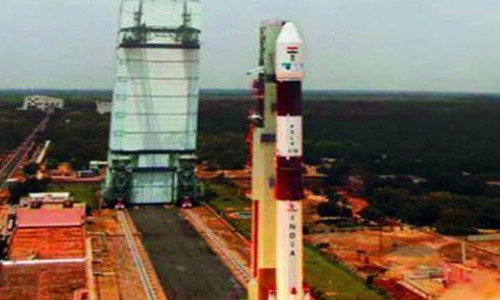Live
- TCS will commence ops in Visakha in 3 months: Lokesh
- Pawan, 2 other ministers rule out VSP privatisation
- HC Bench In Kurnool: House passes unanimous resolution
- Low Pressure Area Likely in Southeast Bay of Bengal, Heavy Rains Forecasted for AP
- Malabar Gold & Diamonds launches new gold jewellery
- Collector reviews arrangements for Guv’s visit
- 13 members of robbery gang arrested
- Country’s development depends on youth’s progress: Collector Vinod
- Exports picking up as mfg gains steam
- CM Revanth Reddy to Attend Commonwealth Mediation and Arbitration Conference Today
Just In

The year 2018 could be termed as one of several new beginnings for the Indian space agency the political sanction for a manned Gaganyaan mission, operationlisation of the heaviest rocket, steps to licence out lithium ion battery technology, introduction of new technologies in rockets and satellites and the decision to go ahead with the Indian Data Relay Satellite System IDRSS, among others
The year 2018 could be termed as one of several new beginnings for the Indian space agency: the political sanction for a manned Gaganyaan mission, operationlisation of the heaviest rocket, steps to licence out lithium ion battery technology, introduction of new technologies in rockets and satellites and the decision to go ahead with the Indian Data Relay Satellite System (IDRSS), among others.
As the year ended, the IAF got its own eye in the sky to exponentially enhance its capabilities.The Indian Space Research Organisation (ISRO) also carried out a sort of `Swachh Bharat' mission - clearing the backlog of satellite launches.
"The year involved hectic activities with several rocket and satellite launch missions. We completed the NAVIC satellite constellation (a regional satellite navigation system similar to GPS) and launched communication satellites like GSAT 29, GSAT 11, GSAT 6A and GSAT 7A. Further, our heaviest rocket, GSLV Mk III, became operational," ISRO Chairman K. Sivan told IANS.
Interestingly Sivan is one of the new beginnings for ISRO as he assumed office in 2018."The major boost was the Gaganyaan announcement by the Prime Minister Narendra Modi. It was a major target announcement. Necessary infrastructure is being augmented," Sivan said.
"During 2018, almost all the technological issues relating to Chandrayaan-2 were sorted out. All the scientific instruments are ready," S. Somanath, Director, Vikram Sarabhai Space Centre (VSSC) told IANS. "With the challenge of realising a human space mission in 2022 an energised ISRO is working hard towards various goals for realising the mission and others," Somanath added.One of the critical projects was the IDRSS.
"There will be two IDRSS satellites of which one is targeted to be flown next year," Sivan said.The IDRSS satellites will be placed in geostationary orbit, enabling satellite to satellite communication and reducing the dependence on the ground stations. This communication is crucial for a manned space mission as there cannot be a risk of being without a connection and data relay.
The year 2018 also saw sanctions for infrastructure augmentation -- connected and non-connected with the proposed manned mission."Approval for a fully electric-propelled satellite has been obtained. Similarly, sanction for additional satellites for the NAVIC system has been obtained. The next version of the reusable launch vehicle has also been sanctioned and augmentation of various infrastructural facilities are happening," Somanath said.
He said approvals for 30 more Polar Satellite Launch Vehicles (PSLVs) have also been obtained to be flown over the years.Over 100 industries have shown interest in ISRO's lithium ion cell technology and 14 companies had been shortlisted. "ISRO has transferred the technology to BHEL for production of space-grade lithium ion batteries for its needs during the year," Somanath added.
The year also saw ISRO crossing the milestone of lifting and putting into orbit over 250 foreign satellites bringing the total to 269 foreign satellites."There is increased demand for satellites from strategic sectors. About six/seven satellites are planned to be built," a senior official told IANS, preferring anonymity.
The GSAT-7 and GSAT-7A are the two dedicated military communication satellites while all other earth observation and communication satellites launched earlier were of dual use -- civilian and defence.Looking forward into 2019, ISRO will also be busy with the Rs 800 crore Chandrayaan-2, India's second moon mission slated in January; flying its new Small Satellite Launch Vehicle (SSLV) rocket.
Somanath said ISRO's new rocket to launch small satellites is being built and will be flown next year. It will be 37-metres tall and weigh 120 tonne. The rocket will be able to to carry satellites weighing 500-700 kg.Somanath said in 2019, about eight PSLV, two GSLV Mk II and two GSLV Mk III, two SSLV and one test GSLV Mk III for Gaganyaan project will be flown.
"A total of over 32 missions -- satellites and rockets -- have been planned for 2019," Sivan said.The one jarring note in ISRO's success symphony in 2018 was the loss of the GSAT-6A satellite couple of days after it was launched in March. The satellite stopped communicating with the ground stations owing to the failure of its power systems.
The GSAT-6A was supposed to compliment GSAT-6 launched in 2015, to help provide technologies for point-to-point communication.
- Venkatachari Jagannathan

© 2024 Hyderabad Media House Limited/The Hans India. All rights reserved. Powered by hocalwire.com







